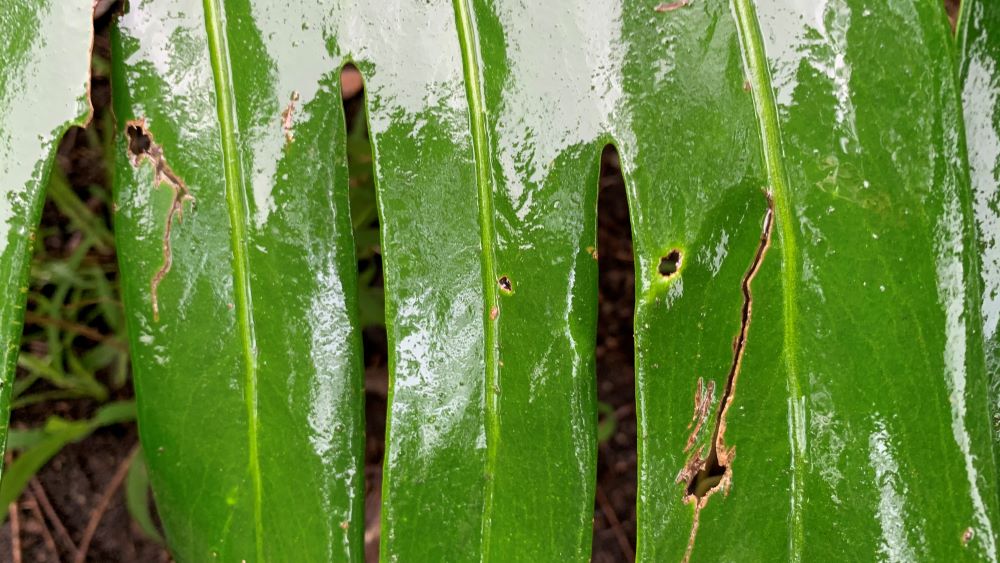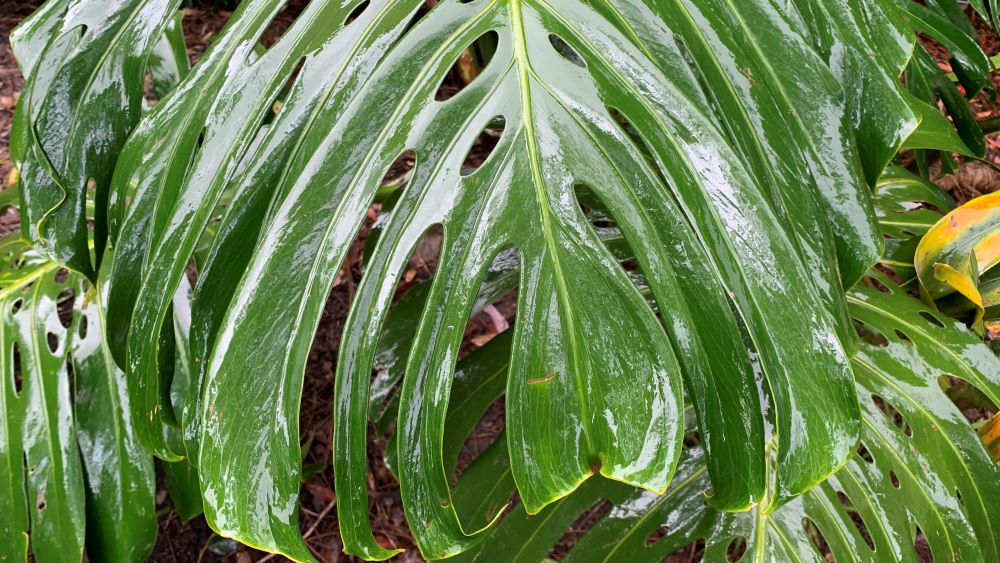Small holes in monstera leaves are usually caused by pests. Scale, spidermite and aphids are common pests that can cause these tiny holes. Scale are most likely to affect indoor monstera. They can find their way in from an open window, or they can already be on your plant. They can also find their way from new plants to your monstera.
Fungal disease can also affect monstera leaves causing small holes with brown and yellow edges. Fungus is more likely to grow if the leaves are misted or if you splash water or soil onto the leaves.
This article will explore the top causes of tiny holes in monstera leaves and how to solve each one. Read through the list to see which one of these problems is causing holes in your monstera leaves.

Causes of tiny holes in monstera leaves
Here are the top cause of tiny holes on your monstera leaves. Check through the list to see if these are causing problems for your monstera.
1. Scale
Scale insects are a common sap sucking bug that can get on your monstera. They form tiny shells over their body which makes them difficult to remove. They will attach themselves tightly to the top or bottom of the leaf sucking sap and water and making holes.
Often you can catch them on the leaf. Look out for tiny 2-3mm shells near the holes.
Scale insects can be treated with neem oil. I find it is best to take your monstera plant outside to spray it with neem oil. Cover the leaves on the top and bottom and spray the stems.

Remember to bring your monstera plant back indoors after spraying it with neem oil. Direct sunlight on the leaves can quickly burn them. Spray the plants early in the morning so that the neem oil has time to dry before the temperature gets too hot.
2. Spidermite
Spidermite are tiny black or brown arachnids that can chew holes in the leaves of your plant. These tiny bugs are fast and are difficult to see. They can leave tiny web-like structures behind but often they go unnoticed.
Spidermite can be treated with neem oil as well. You can wipe the leaves down with a damp cloth to start with to remove any bugs that are obvious. Spray the plant with neem oil and they will usually disappear with 1-2 treatments.
If your monstera plant is growing outdoors you will need to treat the plant again if it rains.
3. Aphids
Aphids are a common pest for monstera that can cause tiny holes. These sap sucking insects attach themselves to the leaves or the stem and will suck the sap, water and nutrient from the plant. They can leave tiny holes behind and can cause damage to your plant.
To get rid of aphid spray the plant with a sharp jet of water. This will remove any aphids without a tight grip. Wait for the plant to dry and spray it with neem oil. These bugs are easier to treat with scale as they don’t have a hard coating over their body.
4. Fungal disease
Monstera plants can be affected by fungus. You can usually recognize fungal disease as the small spots will have yellow borders. They can have brown marks in the middle where the leaf has started to die back.
Fungal disease can be treated with a copper fungicide or look out for an eco friendly option. Treat the disease before it spreads or remove the affected leaf. If you catch it early you can stop it spreading further.
5. Sunburn
Grow lights or intense light from a window can burn tiny holes in monstera leaves. Any direct sunlight can cause damage and it can appear as brown holes or brown edges.

If you water from above and drops of water are left on the leaf they can heat up in the sunlight and burn the leaves.
Avoid placing your monstera in a position that gets direct sun. They can live outdoors as long as they are protected from the harsh sun and have afternoon shade.
Move monstera plants at least 2-3 feet away from windows. This will help to keep the reflected heat off of their leaves. Make sure you place grow lights further away if your plant is developing small holes in their leaves.
How to prevent tiny holes in monstera leaves
Here are my top tips to prevent tiny holes in monstera leaves. This will keep your plant healthy and resistant to pest and fungal attack
1. Avoid watering directly on the leaf
Water your monstera at the root zone and avoid getting water on the leaves. Avoid misting your monstera to reduce the chance of fungus growing on the leaves. I like to take my plant over to my sink and water it thoroughly.
2. Keep monstera at least 3 feet away from windows
Keep monstera plants away from windows which can cause sunburn on the leaves. The radiant heat can quickly damage the leaves.

3. Protect outdoor monstera plants from direct sun
Monstera plants can grow outdoors but they need protection from the sun. Afternoon sun can burn holes through the leaves and cause isolated damage. Place monstera in a position that gets protection from the afternoon sun. The shade of a tree or a shade house is perfect.
4. Treat sap sucking pests with neem oil
If you see sap sucking insects on your monstera treat it with neem oil straight away. The quicker you can deal with them the less likely they will breed out of control.
5. Water and fed monstera regularly
Monstera will grow strong, healthy leaves if they get the water and fertilizer they need. Check the soil and water them every 2 weeks in summer and every 3-4 weeks in winter. Feed the monstera with slow release fertilizer in spring. Monstera are easy care plants so getting the basics right will help to prevent small holes in the leaves.
Tiny Holes in Monstera Leaves | Summary
Monstera plants can develop tiny holes in their leaves if they are exposed to direct sunlight or are attacked by small, sap sucking insects. Fungus can also cause holes so look out for yellowing around the small holes. Keep the plant well watered and give them a small amount of fertilizer to help to strengthen the plant and prevent holes.
Happy growing.
I am an accredited practicing dietitian, experienced gardener and a dedicated cook. I love writing and sharing my experience so you can learn from my successes and mistakes.
